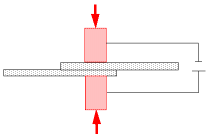A Spot Weld
 connects two or more thin overlapping metal sheets at small areas (spots) without using any filling material.
connects two or more thin overlapping metal sheets at small areas (spots) without using any filling material.
Type

|
Spot weld first face
|
A face of a shell or solid body.
|

|
Spot weld second face
|
A face of a shell or solid body. This face must belong to a different body.
|
 |
Spot weld locations
|
Vertices or reference points. Reference points are projected on the faces to determine the locations of the spot welds.
|

|
Spot weld diameter
|
The maximum diameter is 12.5 mm. |
Symbol Settings
| |
Edit Color
|
Select a color for the symbols.
|

|
Symbol size
|
Set the size of the symbols.
|
| |
Show preview
|
Toggles the display of the connector symbols in the graphics area.
|
Notes
- Available for static, buckling, frequency, and dynamic studies. Not available for composite shells.
- You can define spot welds between two solid or two shell faces or between a solid and shell face.
- Define a No penetration contact condition between the two faces for proper modeling.
Tips
- Available for static, buckling, frequency, and dynamic studSpot welds connect two or more thin overlapping metal sheets at small areas (spots) without using any filling material. Practical considerations set the limit on the total thickness of the joined sheets. The sheets are joined by applying local pressure and heat using shaped copper alloy electrodes. The electrodes apply adequate energy to cause the materials of the sheets to melt and mix together.

After removing the electrodes, the melted material solidifies forming a nugget as shown in the figure.

- Spot welds work best for low carbon steels. Spot welds of alloy steels with high carbon content tend to be brittle and can crack easily. Aluminium sheets can be joined by spot welds due to their low melting point compared to copper, which is the material of the electrodes.
- Spot welds are most practical for joining metal sheets that are up to 3 mm thick. Internally, the program places a cylindrical spot weld connector of diameter D and height 0.5(t1+t2) between the meshed surfaces at the specified location.
-
If the thicknesses of the sheets are not equal, the thickness ratio should not exceed 3. The suggestion is based on practical design considerations and not a limitation of the program. Ideally, the bodies to be spot welded together have to be of equal thicknesses to produce an evenly distributed weld nugget. When not possible, a centered weld nugget is achieved using a larger electrode on the thicker sheet. When the ratio of the thicknesses of the thickest to the thinnest sheet (t1:t2) reaches 3:1, spot welding becomes practically difficult.

- The strength of a spot weld connector depends on the diameter of the weld and the thickness of the sheets. The spot weld diameter should be within the range of 0.5 (t1+t2) < D < (t1+t2) where D is the spot weld diameter.